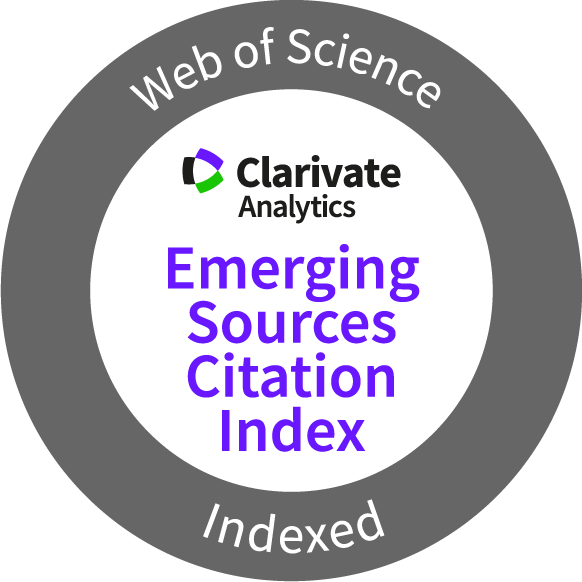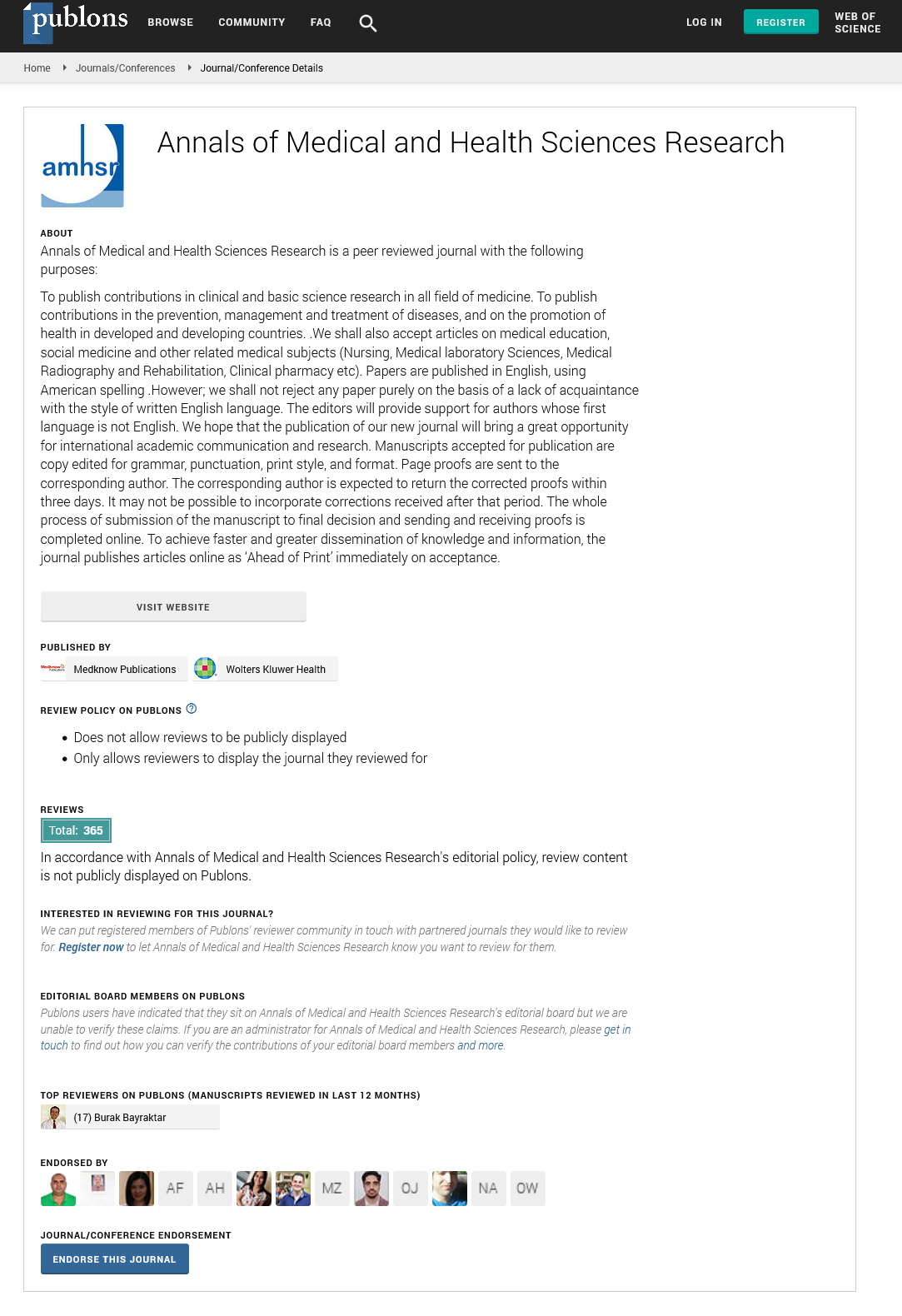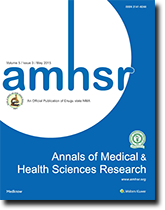Postpartum Practices of Parturient Women in Enugu, South East Nigeria
- *Corresponding Author:
- Dr. TC Okeke
Department of Obstetrics and Gynecology, Unth, Enugu, Nigeria.
E-mail: ubabiketochukwu@yahoo.com
Citation: Okeke TC, Ugwu EO, Ezenyeaku C, Ikeako LC, Okezie OA. Postpartum Practices of Parturient Women in Enugu, South East Nigeria. Ann Med Health Sci Res 2013;3:47-50.
Abstract
Background: Postpartum period is an important and interesting period in the life of the nursing mothers. It is a medically neglected period that receives relatively less attention than pregnancy and delivery. Aim: To describe the postpartum practices of women in Enugu, South East Nigeria. Subject and Methods: This was a cross sectional study of women attending the postnatal care clinic at the UNTH, Enugu. Data was abstracted and analyzed with statistical software for social sciences version 12.0. The results were presented by percentages. Binomial logistic regression was used to determine the association between some socio‑demographic variables and resumption of coitus. P value less than 0.05 was considered statistically significant. Results: Out of the 420 mothers, 68.9% (289/420) resumed coitus within 6 weeks of delivery. Only 14.7% (62/420) used contraception before resumption of coitus. There was no significant association when the model was adjusted for age (OR, 1.132, 95% CI (0.691‑1.867), P = 0.612.), Parity (OR, 1.273, 95% CI (0.812‑1.996), P = 0.292) and education (OR, 0.713, 95% CI (0.433‑1.173), P = 0.183). Twenty five percent [25.2% (106/420)] of the women drank various forms of alcoholic beverages to induce lactation while 80.2% (337/420) of the women applied hot compresses on the lower abdomen to aid lochia drainage and involution of the uterus, 75% (315/420) of the women sat in hot water salt (Nacl) solution (sitz bath) in the immediate postpartum to aid lochia drainage, aid perineal wound healing and improve vaginal tone. Conclusion: There is need for medical attention and education on beneficial postpartum practices among women in Enugu, South East Nigeria. Thus, to reduce the associated maternal morbidities in the postpartum period.
Keywords
Africa, Postpartum period, Postpartum practices, Puerperal period, South East Nigeria, Women
Introduction
Postpartum period is an important and interesting period in the life of the nursing mothers. It is a period in a woman’s life characterized by the return of pelvic organs to non-gravid state, reversal of metabolic change of pregnancy and establishment of lactation,[1-3] a period of life-style modification and psychological adjustment from pregnancy,[3] a period of exclusive breastfeeding, a period of emotional support by their relations and friends, a time to eat and merry for God’s blessings and finally, a period of depression and altered self image.[4]
In Nigeria and other developing countries, factors such as illiteracy, poverty, native customs and cultural beliefs with paucity of health care facilities and personnel, further compound the problems of postpartum in our women.[2] Certain practices are affordable, beneficial, harmful or culturally acceptable and may have symbolic importance to local people.[5] These traditional practices and home remedies are often promoted by grand-mothers, village healers, midwives, native physicians, community leaders and quacks.[5]
In terms of medical attention, postpartum period is generally neglected and receives relatively less attention than pregnancy, labour and delivery.[2,3,6] This has resulted in increased maternal morbidities and mortalities due to inadequate care of women in South East, Nigeria.[6-8] In view of this, women are often readmitted with complications such as perineal wound infections, accidents, puerperal sepsis, thromboembolism,[2] mental disorder,[9] postpartum eclampsia and secondary postpartum hemorrhage.[1-3]
This study therefore looks into the postpartum practices of parturient women in Enugu, South East Nigeria, since postpartum health has received very little attention of researchers and health practitioners in developing countries,[2] with the aim of identifying the hazardous practices and ways to eradicate them.
Subject and Methods
This was a 6-month cross sectional study of women attending the postnatal care clinic at the University of Nigeria Teaching Hospital (UNTH), Enugu. A total of 440 women were consecutively recruited after obtaining their written informed consents. A self administered structured pretested questionnaire was used to collect data about the women’s socio-demographic characteristics (age, marital status, parity, and educational status), postpartum activities (perineal hygiene, time at resumption of coitus postpartum, use of contraceptives, dietary habits and use of herbs, induction of lactation, means of aiding lochia drainage, means of aiding perineal wound healing, weight loss postpartum, and general health of the women.
The data were entered and analyzed by descriptive and inferential statistics using statistical software SPSS version 12 (SPSS Inc. Chicago IL). The results were presented by simple percentages. Data was presented descriptively as percentage. Binomial logistic regression was used to determine the association between some socio-demographic variables and resumption of coitus.
P value less than 0.05 was considered statistically significant.
Ethical clearance
Ethical review and clearance was obtained from the University of Nigeria Hospital Research Ethics Committee. The study protocol was approved by the hospital review board. Department protocol was via informed written consent prior to data collection. Verbal informed consent was obtained from the study participants.
Results
Four hundred and twenty (420) questionnaires were correctly filled and retrieved giving a response rate of 95.4%. The women were between the ages of 16 and 42 years with 75% (315/420) of them below 30 years. Majority of the women 54.8% (230/420) were multi-parous and 97.6% (410/420) had formal education at least up to primary education [Table 1]. Three hundred and ninety six (94.3% (396/420)) had satisfactory perineal hygiene. Resumption of coitus within 6 weeks of delivery occurred in 68.9% (289/420) of the women. Only 14.8% (62/420) used contraception before resumption of coitus after delivery. There was no significant association when the model was adjusted for age, (OR, 1.132, 95% CI (0.691-1.867), P = 0.612.), Parity (OR, 1.273, 95% CI (0.812-1.996), P = 0.292) and education. (OR, 0.713, 95% CI (0.433-1.173), P = 0.183 as shown in Table 2. One hundred and six (25.2% (106/420) mothers drank various forms of alcoholic beverages (Palm wine, stout, illicit gin etc.) to induce lactation. Hot compresses on the lower abdomen was applied by 80.2% (337/420) to aid lochia drainage and involution of the uterus, while 75% (315/420) sat in hot water salt solution (sitz bath) in the immediate postpartum to aid lochia drainage and perineal wound healing, and improve vaginal tone. Only 18% (76/420) of the mothers were able to return to their pre-pregnancy weight by 6 weeks postpartum while 82% (344/420) of the mothers returned to their normal pre-pregnancy weight by 6 months postpartum. All these are illustrated in Table 3.
| Socio-demographic characteristics | No. (%) | |
|---|---|---|
| Age | ||
| ≤20 | 42 (10) | |
| 21-30 | 273 (65) | |
| 31-40 | 88 (21) | |
| >40 | 17 (4) | |
| Marital status | ||
| Single | 22(5.2) | |
| Married | 398(94.8) | |
| Party | ||
| 1 | 148 | |
| 2-4 | 230(54.7) | |
| ≥5 | 42 (10.0) | |
| Educational status | ||
| No formal education | 10(2.4) | |
| Primary | 85 (20.2) | |
| Secondary | 205(48.8) | |
| Tertiary | 120(28.6) | |
Table 1: Socio demographic characteristics of women
| Biodata | Yes (%) | No (%) | Total (%) |
|---|---|---|---|
| Age | |||
| ≤30 years | 224 (71.1) | 91 (28.9) | 315 |
| >30 years | 65 (61.9) | 40 (38.1) | 105 |
| Total | 289 | 131 | 420 |
| Age (OR, 1.132, 95% CI (0.691-1.867), P=0.612) | |||
| Parity | |||
| Primipara (1) | 109 (73.6) | 39 (26.4) | 148 |
| Multipara (>1) | 180 (66.2) | 92 (33.8) | 272 |
| Total | 289 | 131 | 420 |
| Parity (OR, 1.273, 95% CI (0.812-1.996), P=0.292) | |||
| Educational level | |||
| Nontertiary education | 206 (68.7) | 94 (31.3) | 300 |
| Tertiary education | 83 (69.2) | 37 (30.8) | 120 |
| Total | 289 | 131 | 420 |
Table 2: Relationship between age, parity, educational level and resumption of coitus before 6 weeks postpartum
| Postpartum practices | No. | % |
|---|---|---|
| Breast feeding | ||
| At birth | 345 | 82.1 |
| At 6 weeks | 215 | 51.2 |
| At 6 months | 110 | 26.2 |
| At 9 months | 68 | 16.2 |
| Induction of lactation | ||
| Use of alcoholic beverages | 106 | (25.2) |
| Local food/use of herbs | 88 | (21.0) |
| None | 226 | (53.8) |
| Aiding lochia drainage | ||
| No application | 20 | (4.8) |
| Hot compresses to lower abdomen | 337 | (80.2) |
| Local food/use of herbs | 63 | (15.0) |
| Aiding perineal wound healing | ||
| No application | 40 | (9.5) |
| Sitz bath | 315 | (75.0) |
| Application of herbs | 65 | (15.5) |
| Resumption of coitus after delivery | ||
| <4 weeks | 88 | (21.0) |
| 4-6 weeks | 201 | (47.9) |
| >6 weeks | 131 | (31.1) |
Table 3: Postpartum practices among women of South East, Nigeria
Discussion
Postpartum activities as practiced in developing countries are sometimes beneficial, innocuous or harmful. Beneficial practices are good and worth promoting while hazardous practices are bad and should be stopped. If these practices are strictly adhered to, maternal morbidities will be reduced in the postpartum period.
In this study, majority of the women breastfed their babies at birth thus, demonstrating the acceptance and special significance of breastfeeding in Nigeria. Infant survival depends heavily on it. It is associated with major gains in reproductive health and fertility control.[10] Breastfeeding is beneficial practice in postpartum period because it is natural, cheap, readily available, uncontaminated, protective, not a constant substance[2] and initiates bonding of the woman and her baby.[1-3] Breast milk is the ideal nutrition for the human baby.[2] However, in this study, breastfeeding dropped to 26.2% at 6 months and 16.2% at 9 months postpartum. The current decline in breastfeeding in the developing world is a cause for great concern in our poor resource setting with a low contraceptive usage in the postpartum period. This may invariably result in population explosion.[2,3]
Resumption of coitus early in postpartum period is harmful and should be discouraged. Previous studies in Nigeria[6,11,12] noted associated maternal morbidities like vaginal lacerations, hemorrhage and associated vaginitis. This early resumption of coitus is often without contraception thus exposing mothers to dangers of unwanted pregnancy. In South East Nigeria, a reasonable number of women deliver outside hospitals and had no form of antenatal care.[13] These women did not receive both antenatal care counseling and postnatal family planning counseling. Thus, they are not aware of the benefits of contraception in the postpartum period and do not believe that conception can even occur soon after delivery even when they are on exclusive breastfeeding. The consequence of this is that mothers may get involved in illegal induced abortion because of unwanted pregnancy in order to breastfeed their young baby who has not reached 6-12 months of age.
Only 18% of the women in this study returned to their pre-pregnancy weight by 6 weeks postpartum. Postpartum weight retention affects many women and increases the risk of becoming overweight.[14,15] Since one in five women had complete weight reduction 6 weeks postpartum, effective interventions are still needed for the prevention of weight retention in the remaining 82% of the women postpartum.[16]
In this study, age, parity and educational level of mothers are not significantly associated with the resumption of coitus before 6 weeks postpartum. This finding is in agreement with previous report.[6]
In South East Nigeria, women as demonstrated in this study have an old tradition of use of hot water salt (Nacl) solution sitz baths compresses on lower abdomen in the immediate postpartum period. This is used with view to aiding lochia drainage, perineal wound healing and improving both anterior abdominal muscle tone and vaginal tone. However, this practice is hazardous to the women; the birth perineal lacerations and episiotomies that are repaired with absorbable chromic catgut sutures are destroyed by hot water sitz baths with resultant perineal burns and wound dehiscence. Those that apply local herbs to the perineal wound become predisposed to wound infections which later heal by secondary intention with fibrosis and extensive scar tissue formation. This may eventually result in gynaetresia and development of dyspareunia.
The use of alcoholic beverages (palm wine, stout, illicit gin etc.) to induce lactation few hours after delivery is no doubt hazardous. This practice is very prevalent in South East Nigeria as demonstrated in this study. It is an age long tradition in the region. The grandmothers maintain that they used it and it worked for them that no amount of education will convince them to drop this practice and so they insist that their daughters use them as well. There is no evidence to support this old practice. It is certain that once a baby is put to the breast sucking initiates let down reflex and milk ejection is achieved.[17] Alcoholic beverages cause gastritis to the women since they have labored all through with little or no food from active stage of labour till 3rd stage is completed.[18]
The limitation of this study was the restriction of sample population to the UNTH Enugu. The women who received care in other health institutions outside UNTH and those who received no care at all were not included in the study. Furthermore, the cross sectional nature of the study allowed for finding associations but did not allow for definitive conclusions on cause and effect. However, this is a stepping stone towards further research on postpartum practices among Nigerian women.
Source of Support: Nil.
Conflict of Interest: No conflicts of interest,
financial or otherwise, are declared by the authors.
References
- Ekwempu CC Jr, Otubu JA. Abnormal puerperium. In: Agboola A, editor. Textbook of Obstetrics and Gynecology for medical students. 2nd ed. Ibadan: Heinemann Educational Books Plc.;2006. p. 504-8.
- Howie PW. The puerperium. In: Edmonds DK, editor. Dewhurst’s textbook of Obstetrics and Gynecology for postgraduates. 6th ed. Oxford: Black Well Science; 1999. p. 342-53.
- Arulkumaran S, Tamizian O. Care in the puerperium. In: Arulkumaran S, Symonds IM, Fowlie A, editors. Oxford handbook of Obstetrics and Gynecology. 2nd ed. New Delhi: Oxford University Press; 2004. p. 365-71.
- Okeudo C, Ezem BU, Ojiyi EE. Stillbirth rate in a teaching hospital in South-Eastern Nigeria: A silent Tragedy. Ann Med Health Sci Res 2012;2:176-9.
- Manandhar DS, Costello A. Diseases of the newborn. In: Lawson JB, Harrison KA, Bergstrom S, editors. Maternity care in developing countries. 1st published. London: RCOG Press; 2001. p. 264-83.
- Ekanem AD, John ME, Ekott ME, Udoma EJ. Post-partum practices among women in Calabar, Nigeria. Trop Doct 2004;34:97-8.
- Adetoro OO, Okwerekwu FO, Ogumbode O. Maternal mortality at Ilorin, Nigeria (special edition). Trop J Obstet Gynecol 1988;1:18-22.
- Mutihir JT, Utoo BT. Postpartum maternal morbidity in Jos, North-central Nigeria. Niger J Clin Pract 2011;14:38-42.
- Glazener CM, Mac Arthur C, Garcia J. Post natal care: Time for a change. Contemp Rev Obstet Gynecol 1993;5:130-6.
- Harrison KA, Lawson JB. Puerperal disorders. In: Lawson JB, Harrison KA, Bergstrom S, editors. Maternity care in developing countries. 1st published. London: RCOG Press; 2001. p. 231-44.
- Iloabachie GC. Vaginal injuries at coitus (a shift in emphasis to the minors). Trop J Obstet Gynecol 1990;8:34-6.
- Ezechi OC, Fasuba OB, Dare FO. Vaginal injuries during coitus at Ile-Ife: A 16 year review. Niger J Med 2000;9:16-8.
- Ibekwe PC, Ugboma HU, Onyire N, Muoneke U. Perinatal mortality in southern Nigeria; less than half a decade to the millennium developmental goals. Ann Med Health Sci Res 2011;1:215-22.
- Althuizen E, van Popple MN, de Vries JH, Seidell JC, van Mechelen W. Postpartum behavior as predictor of weight change from before pregnancy to one year postpartum. BMC Public Health 2011;11:165.
- Puerperium and Lactation. In: Edmonds DK, editor. Dewhurst’s textbook of Obstetrics and Gynecology. 7th ed. Oxford: Blackwell Publishing; 2007. p. 69-80.
- Gore SA, Brown DM, West DS. The role of postpartum weight retention in obesity among women: A review of the evidence Ann Behav Med 2003;26:146-59.
- Normal Puerperium. In: Daftary S, Chakravarti S, editors. Manual Obstetrics. 1st ed. New Delhi: Elsevier; 2004. p. 305-13.
- Walker MJ, AL-Sahab B, Islam F, Tamin H. The epidemiology of alcohol utilization during pregnancy: An analysis of the Canadian maternity experience survey (MES). BMC Pregnancy Childbirth 2011;12:11-52.




 The Annals of Medical and Health Sciences Research is a monthly multidisciplinary medical journal.
The Annals of Medical and Health Sciences Research is a monthly multidisciplinary medical journal.